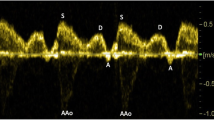Abstract:
Objectives
Fetal ductus venosus (DV) blood flow velocity waveforms are significantly altered during contractions in first stage of labor. We have evaluated the reproducibility of these waveforms during and between contractions.
Methods
90 women between 37th and 41st week of gestation were included in the study. The measurements of the DV were obtained by three different investigators during and between contractions. The pulsatility index for veins (PIV), peak velocity index for veins (PVIV), and fetal heart rate (FHR) were calculated offline. Furthermore, differences in PVIV (PVIVdiff) and PIV (PIVdiff) and a mean of FHR (FHRmean) were calculated. Statistical analysis was used to verify differences in the PIV, PVIV and FHR during and between contractions of each subgroup as well as for the PVIVdiff, PIVdiff and FHRmean between the subgroups.
Results
Investigator 1 examined 49 patients (group 1); investigator 2, 17 patients (group 2) and investigator 3, 24 patients (group 3), respectively. In all subgroups, there was a significant difference for the PVIV and PIV during and between contractions, but not for FHR. There was a correlation between gestational age and PVIVdiff, PIVdiff and FHRmean as well as for maternal age and PVIVdiff and PIVdiff. PVIVdiff and PIVdiff showed significant differences in group 1 compared to groups 2 and 3 (p < 0.001), but not between groups 2 and 3.
Conclusions
Significant differences in the measurements in the three subgroups have been revealed, which may be due to different timing of measurement during the contraction. For future studies further standardization of the measurement protocol should be established.


Similar content being viewed by others
References
Thacker SB, Stroup DF (2000) Continuous electronic heart rate monitoring for fetal assessment during labor. Cochrane Database Syst Rev 2:CD000063
Agrawal SK, Doucette F, Gratton R, Richardson B, Gagnon R (2003) Intrapartum computerized fetal heart rate parameters and metabolic acidosis at birth. Obstet Gynecol 102:731–738
East CE, Leader LR, Sheehan P, Henshall NE, Colditz PB (2010) Intrapartum fetal scalp lactate sampling for fetal assessment in the presence of a non-reassuring fetal heart rate trace. Cochrane Database Syst Rev 17:CD006174
Klauser CK, Christensen EE, Chauhan SP, Bufkin L, Magann EF, Bofill JA, Morrison JC (2005) Use of fetal pulse oximetry among high-risk women in labor: a randomized clinical trial. Am J Obstet Gynecol 192:1810–1817
Dervaitis KL, Poole M, Schmidt G, Penava D, Natale R, Gagnon R (2004) ST segment analysis of the fetal electrocardiogram plus electronic fetal heart rate monitoring in labor and its relationship to umbilical cord arterial blood gases. Am J Obstet Gynecol 191:879–884
Marsál K (2009) Obstetric management of intrauterine growth restriction. Best Pract Res Clin Obstet Gynaecol 23:857–870
Huhta JC, Paul JJ (2010) Doppler in fetal heart failure. Clin Obstet Gynecol 53:915–929
Baschat AA, Güclü S, Kush ML, Gembruch U, Weiner CP, Harman CR (2004) Venous Doppler in the prediction of acid–base status of growth-restricted fetuses with elevated placental blood flow resistance. Am J Obstet Gynecol 191:277–284
Kiserud T (2001) The ductus venosus. Semin Perinatol 25:11–20
Krapp M, Denzel S, Katalinic A, Berg C, Germer U, Gembruch U (2002) A preliminary study of fetal ductus venosus blood flow during the first stage of labor. Arch Gynecol Obstet 267:19–22
Krapp M, Denzel S, Katalinic A, Berg C, Smrcek J, Geipel A, Gembruch U (2002) Normal values of fetal ductus venosus blood flow waveforms during the first stage of labor. Ultrasound Obstet Gynecol 19:556–561
Szunyogh N, Zubor P, Dokus K, Galo S, Visnovsky J, Danko J (2006) Uterine activity and ductus venosus flow velocity patterns during the first stage of labor. Int J Gynaecol Obstet 95:18–23
Hecher K, Campbell S, Snijders R, Nicolaides K (1994) Reference ranges for fetal venous and atrioventricular blood flow parameters. Ultrasound Obstet Gynecol 4:381–390
Szunyogh N, Galo S, Zubor P, Visnovsky J (2006) Atypical ductus venosus blood flow pattern during a prolonged fetal heart rate deceleration in labor. Ultrasound Obstet Gynecol 27:712
Acknowledgments
The study was generously supported by a Grant of the German Research Foundation. We would like to thank S.D. and M.P. for their participation in data acquisition.
Conflict of interest
We declare that we have no conflict of interest.
Author information
Authors and Affiliations
Corresponding author
Rights and permissions
About this article
Cite this article
Krapp, M., Kühn, A., Baumann, K. et al. Reproducibility of fetal ductus venosus blood flow velocity waveforms during first stage of labor. Arch Gynecol Obstet 285, 87–92 (2012). https://doi.org/10.1007/s00404-011-1913-y
Received:
Accepted:
Published:
Issue Date:
DOI: https://doi.org/10.1007/s00404-011-1913-y




